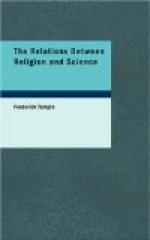make up the subject, that which I mean when I use
the words I myself; the other the object or that which
is not I. But there is absolutely nothing to determine
which is which, which class is the subject and which
is the object, which is I myself, and which is not
I myself. Vividness and faintness plainly have
nothing in them by which we can assign the one to that
which is I, the other to that which is not I. If we
were to conjecture, we should be disposed to say that
surely the most vivid sensations must be the nearest
and therefore must be part of that which is I; but
we find it is quite the other way. The faint
sensations are characteristic of that which is I,
and the vivid of that which is not I. And the same
remark applies to each pair of characteristics in
succession. The fact is that Mr. Spencer has
omitted what is essential to complete his argument;
he has not shown, nor endeavoured to show, nor even
thought of showing, how out of his seven characteristics
of the subject the conception of a subject has grown.
It is quite plain that he not only makes his classes
first and finds his characteristics afterwards, which
we may admit to have been inevitable; but he fails
altogether to show how that by which we know the classes
apart has grown out of the characteristics that he
has given us. The characteristics which he assigns
to that which is I, all added together, do not in
the slightest degree account for that sense of permanent
existence in spite of changes which lies at the root
of my distinction of myself from other things.
The very word same, in the sense in which I use it
when speaking of myself, cannot be defined except
by reference to my own sameness with myself. It
is a simple idea incapable of analysis, and is indeed,
as was pointed out in my last Lecture, the root of
the character of permanence which we assign to things
external. To say that this conception has been
evolved from the characteristics that Mr. Spencer
has enumerated is like saying that a cat has been
evolved without any intermediate stages from a fish,
or a smell from a colour.
But, if we now go a step further, and ask in what
form this personal identity presents itself in the
world of phenomena, the answer is clear: our
personality while bound up with all our other faculties,
so that we can speak of our understanding, our affections,
our powers of perception and sensation, as parts of
ourselves, yet is centred in one faculty which we
call the will. ‘If there be aught spiritual
in man,’ says Coleridge, ’the will must
be such. If there be a will, there must be a
spirituality in man.’ The will is the man.
It is the will that makes us responsible beings.
It is for the action of our will, or the consent of
our will, that we come to be called in question.
It is by the will that we assert ourselves amidst
the existences around us; and as the will is the man
in relation to phenomena, so on the other side the
will is the one and only force among the forces of




